
Tango Music

The Bandoneón
Ángel Villoldo
D'Arienzo & Troilo
Grela & Arias
Salgán & Piazzolla
Tango & Jazz
The Bandoneón
Accompanying Materials to Chapter 2:
The Bandoneón: The Magical Sound and Soul of Tango
by Ortaç Aydınoğlu
 WE 2.1. “La yumba” (referencing Pugliese’s signature rhythmic technique), Pugliese, 1946 version, bandoneones playing melody and accompaniment. Transcribed by the author. For audio, see WL 2.12.
WE 2.1. “La yumba” (referencing Pugliese’s signature rhythmic technique), Pugliese, 1946 version, bandoneones playing melody and accompaniment. Transcribed by the author. For audio, see WL 2.12.
WE 2.1. “La yumba” (referencing Pugliese’s signature rhythmic technique), Pugliese, 1946 version, bandoneones playing melody and accompaniment. Transcribed by the author. For audio, see WL 2.12. 
WE 2.2. “Quejas de bandoneón” (“Wail of the Bandoneón”), 1958 version, Troilo’s bandoneón left-hand solo, mm: 36–45. Transcribed by the author. For audio, see WL 2.16. 
WE 2.3. “A Evaristo Carriego” (“To Evaristo Carriego”), Orquesta Color Tango version, mm. 48–51, bandoneón right-hand solo with octave appogiaturas in m. 50. Transcribed by the author. For audio, see WL 2.18. 
WE 2.4. Bandoneones soli melody in sixths with dialog between hands, “Recuerdo” (“Remembrance”) Pugliese, 1944 version, mm. 17–23. Transcribed by the author. For audio, see WL 2.20. 
WL 2.4. “Heliotropo” (“Heliotrope,” type of flower), composed and performed by Pedro Maffia. Excerpt from the film Fuelle querido (Dear Bellows), film directed by Mauricio Berú, 1966, cue 5:10.
WL 2.6. “Amurado” (“Abandoned” in Lunfardo) by Pedro Maffia and Pedro Laurenz, performed by Pedro Laurenz, 1952.
WL 2.13. “Canaro en París” (“Canaro in Paris”) by Juan Caldarella and Alejandro Scarpino, performed by Quinteto Pirincho, 1940, bandoneón variations 2:06–2:35.
WL 2.17. “Inspiración” (“Inspiration”) by Peregrino Paulos, recorded by Ciriaco Ortiz, 1936, illustrating fraseos octavados as appoggiaturas, 0:24–0:36; playing both as appoggiaturas and in octaves, 0:30–0:45; and playing in 3rds and 6ths, 1:55–2:25.
WL 2.19. “Café Domínguez” (“Cafe Dominguez”) by Ángel D’Agostino, performed by TangEsta, 2018, playing a melody with both hands in parts as a duet, 1:04–1:20.
WL 2.21. “El andariego” (“The Walker”) by Alfredo Gobbi, recorded by Osvaldo Pugliese y su orquesta típica, 1972, left-hand soli part in voices, 0:06–0:17.
Ahrens, Christian. “Free Reed.” In The Organ: An Encyclopedia, edited by Douglas E. Bush and Richard Kassel, 210–211. New York: Routledge Taylor & Francis Group, 2006.
Aydınoğlu, Ortaç. “Arjantin Tango Müziğinde Orkestrasyon Stilleri (Orchestration Styles in Argentine Tango Music).” PhD diss., İstanbul Technical University, 2019.
Bush, Douglas E., and Richard Kassel. The Organ: An Encyclopedia. New York: Routledge Taylor & Francis Group, 2006.
Cimadevilla, Santiago. “Construction of Bandoneón Solos in Argentine Tango Music.” Artistic Research, Codarts World Music Academy. Rotterdam, Netherlands: 2012.
Dibb, Mike. director. Astor Piazzolla in Portrait. Opus Arte, 2004.
Gorin, Natailo. Astor Piazzolla: A Memoir. Portland, OR: Amadeus Press, 2001.
Hasse, Julián. 50 Variaciones Para Estudio Diario, Volume 2. Buenos Aires: Altavoz, 2008.
Hermosa, Gorka. The Accordion in the 19th Century. Spain: Kattigara, 2013.
Heveling, Carsten. “Das Bandoneon.” Bandoneon, accessed July 27, 2021, https://bando-bando.de/verschiedenes/foto.html.
“History,” Accordions Worldwide, accessed July 24, 2021. www.accordions.com/history/acc_his.aspx.
“History: Extract from the history of Carlsfeld,” Carlsfeld, accessed July 26, 2021, www.carlsfeld.com/history.html.
Kerimov, Rauf. “Akordiyon ve Benzeri Armonikaların Tarihsel Gelişimi Üzerine Bir İnceleme.” Porte Akademik (Spring 2018): 87–101.
Krüger, Janine. Heinrich Band. Bandoneon: Die Reise eines Instruments aus dem niederrheinischen Krefeld in die Welt. Essen: Klartext Verlag, 2020.
Krapovickas, Mercedes. “Organografía del bandoneón y prácticas musicales: Lógica dispositiva de los teclados del bandoneón rheinische Tonlage 38/33 y la escritura ideográfica.” Latin American Music Review (Fall/Winter 2012): 157–185.
Kutnowski, Martín. “Instrumental Rubato and Phrase Structure in Astor Piazzolla’s Music.” Latin American Music Review 23, no. 1 (2002): 106–113.
Lavocah, Michael. Tango Masters: Aníbal Troilo. Norwich: Milonga Press, 2014.
Link, Kacey, and Kristin Wendland. Tracing Tangueros. New York: Oxford University Press, 2016.
Mamone, Pascual, with Diego Sauchelli and Julián Hasse, Tratado de Orquestación en Estilos Tangueros. Buenos Aires: Alvatoz Ediciones Musicales, 2011.
Montagu, Jeremy. “Concertina.” In The Oxford Companion to Music, edited by Alison Latham, 288. New York: Oxford University Press, 2002.
Montagu, Jeremy. “Reed.” In The Oxford Companion to Music, edited by Alison Latham, 1038. New York: Oxford University Press, 2002.
Owen, Barbara, and Richard Partridge. “Free Reed.” In Grove Music Online. Edited by Stanley Sadie. New York: Oxford University Press, 2001.
Peralta, Julián. La orquesta típica: mecánica y aplicación de los fundamentos técnicos del tango. Buenos Aires: Departmento de Impresiones de la H. C. D de la Provincia de Buenos Aires, 2008.
Pinsón, Néstor. “Aníbal Troilo.” Todotango, accessed October 9, 2021, www.todotango.com/english/artists/biography/50/Anibal-Troilo.
Sachs, Curt. The History of Musical Instruments. New York: Dover Publications, 2006.
Salgán, Horacio. Curso de Tango. Buenos Aires: Pablo J. Polidoro, 2001.
Sevsay, Ertuğrul. The Cambridge Guide to Orchestration. New York: Cambridge University Press, 2013.
Sierra, Adolfo Luis. Historia de la orquesta típica: evolución instrumental del tango. Buenos Aires: Peña Lillo, 1976.
Solis, Marcelo. “History of Tango – Part 5: The Appearance of the Bandoneon in Tango.” Argentine Tango School, accessed July 27, 2021, https://escuelatangoba.com/marcelosolis/history-of-tango-part-5.
Thompson, Robert Farris. Tango: The Art History of Love. New York: Pantheon Books, 2005.
Wolff, Eva. The Bandoneón in Tango. Buenos Aires: Tango Sinfin, 2018.
Zucchi, Oscar. “The Bandoneon, Name, Origin and Manufacturers.” Todotango, accessed July 27, 2021, www.todotango.com/english/history/chronicle/149/The-bandoneon-name-origin-and-manufacturers.
“The Bandoneon in the River Plate, Part II.” Todotango, accessed July 27, 2021, www.todotango.com/english/history/chronicle/202/The-Bandoneon-in-the-River-Plate-Part-II.
Ahrens, Christian. “Free Reed.” In The Organ: An Encyclopedia, edited by Douglas E. Bush and Richard Kassel, 210–211. New York: Routledge Taylor & Francis Group, 2006.
Aydınoğlu, Ortaç. “Arjantin Tango Müziğinde Orkestrasyon Stilleri (Orchestration Styles in Argentine Tango Music).” PhD diss., İstanbul Technical University, 2019.
Bush, Douglas E., and Richard Kassel. The Organ: An Encyclopedia. New York: Routledge Taylor & Francis Group, 2006.
Cimadevilla, Santiago. “Construction of Bandoneón Solos in Argentine Tango Music.” Artistic Research, Codarts World Music Academy. Rotterdam, Netherlands: 2012.
Dibb, Mike. director. Astor Piazzolla in Portrait. Opus Arte, 2004.
Gorin, Natailo. Astor Piazzolla: A Memoir. Portland, OR: Amadeus Press, 2001.
Hasse, Julián. 50 Variaciones Para Estudio Diario, Volume 2. Buenos Aires: Altavoz, 2008.
Hermosa, Gorka. The Accordion in the 19th Century. Spain: Kattigara, 2013.
Heveling, Carsten. “Das Bandoneon.” Bandoneon, accessed July 27, 2021, https://bando-bando.de/verschiedenes/foto.html.
“History,” Accordions Worldwide, accessed July 24, 2021. www.accordions.com/history/acc_his.aspx.
“History: Extract from the history of Carlsfeld,” Carlsfeld, accessed July 26, 2021, www.carlsfeld.com/history.html.
Kerimov, Rauf. “Akordiyon ve Benzeri Armonikaların Tarihsel Gelişimi Üzerine Bir İnceleme.” Porte Akademik (Spring 2018): 87–101.
Krüger, Janine. Heinrich Band. Bandoneon: Die Reise eines Instruments aus dem niederrheinischen Krefeld in die Welt. Essen: Klartext Verlag, 2020.
Krapovickas, Mercedes. “Organografía del bandoneón y prácticas musicales: Lógica dispositiva de los teclados del bandoneón rheinische Tonlage 38/33 y la escritura ideográfica.” Latin American Music Review (Fall/Winter 2012): 157–185.
Kutnowski, Martín. “Instrumental Rubato and Phrase Structure in Astor Piazzolla’s Music.” Latin American Music Review 23, no. 1 (2002): 106–113.
Lavocah, Michael. Tango Masters: Aníbal Troilo. Norwich: Milonga Press, 2014.
Link, Kacey, and Kristin Wendland. Tracing Tangueros. New York: Oxford University Press, 2016.
Mamone, Pascual, with Diego Sauchelli and Julián Hasse, Tratado de Orquestación en Estilos Tangueros. Buenos Aires: Alvatoz Ediciones Musicales, 2011.
Montagu, Jeremy. “Concertina.” In The Oxford Companion to Music, edited by Alison Latham, 288. New York: Oxford University Press, 2002.
Montagu, Jeremy. “Reed.” In The Oxford Companion to Music, edited by Alison Latham, 1038. New York: Oxford University Press, 2002.
Owen, Barbara, and Richard Partridge. “Free Reed.” In Grove Music Online. Edited by Stanley Sadie. New York: Oxford University Press, 2001.
Peralta, Julián. La orquesta típica: mecánica y aplicación de los fundamentos técnicos del tango. Buenos Aires: Departmento de Impresiones de la H. C. D de la Provincia de Buenos Aires, 2008.
Pinsón, Néstor. “Aníbal Troilo.” Todotango, accessed October 9, 2021, www.todotango.com/english/artists/biography/50/Anibal-Troilo.
Sachs, Curt. The History of Musical Instruments. New York: Dover Publications, 2006.
Salgán, Horacio. Curso de Tango. Buenos Aires: Pablo J. Polidoro, 2001.
Sevsay, Ertuğrul. The Cambridge Guide to Orchestration. New York: Cambridge University Press, 2013.
Sierra, Adolfo Luis. Historia de la orquesta típica: evolución instrumental del tango. Buenos Aires: Peña Lillo, 1976.
Solis, Marcelo. “History of Tango – Part 5: The Appearance of the Bandoneon in Tango.” Argentine Tango School, accessed July 27, 2021, https://escuelatangoba.com/marcelosolis/history-of-tango-part-5.
Thompson, Robert Farris. Tango: The Art History of Love. New York: Pantheon Books, 2005.
Wolff, Eva. The Bandoneón in Tango. Buenos Aires: Tango Sinfin, 2018.
Zucchi, Oscar. “The Bandoneon, Name, Origin and Manufacturers.” Todotango, accessed July 27, 2021, www.todotango.com/english/history/chronicle/149/The-bandoneon-name-origin-and-manufacturers.
“The Bandoneon in the River Plate, Part II.” Todotango, accessed July 27, 2021, www.todotango.com/english/history/chronicle/202/The-Bandoneon-in-the-River-Plate-Part-II.
Ángel Villoldo
Accompanying Materials to Chapter 3:
Ángel Villoldo and Early Sound recordings
by Morgan James Luker
WP 3.1. Ángel Villoldo. Wikimedia, public domain. https://commons.wikimedia.org/wiki/Category:%C3%81ngel_Villoldo#/media/File:%C3%81ngel_Villoldo_(1861-1919).jpg
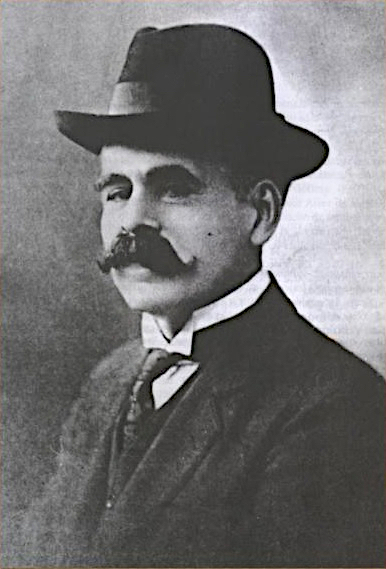
WP 3.1. Ángel Villoldo. Wikimedia, public domain. https://commons.wikimedia.org/wiki/Category:%C3%81ngel_Villoldo#/media/File:%C3%81ngel_Villoldo_(1861-1919).jpg

WL 3.2. “El choclo” recorded by the Banda Española, 1907. https://adp.library.ucsb.edu/index.php/matrix/detail/2000044576/06011-El_choclo.
WL 3.3. “El choclo” recorded by the Hurtado Brothers Royal Marimba Band of Guatemala, 1916. https://adp.library.ucsb.edu/index.php/matrix/detail/700002516/B-17486-El_choclo.
WL 3.5. “El choclo” recorded by the Pietro Deiro Accordion Trio, 1932. https://adp.library.ucsb.edu/index.php/matrix/detail/800038684/BSHQ-73022-El_choclo.
WL 3.9. “El choclo,” renamed “Kiss of Fire,” recorded by Georgia Gibbs, 1952.
Brown, Bill. Other Things. Chicago: University of Chicago Press, 2015.
Cañardo, Marina. Fábricas de músicas: Comienzos de la industria discográfica en la Argentina (1919–1930). Buenos Aires: Gourmet Musical, 2017.
Chamosa, Oscar. The Argentine Folklore Movement: Sugar Elites, Criollo Workers, and the Politics of Cultural Nationalism, 1900–1955, 2nd ed. Tucson: University of Arizona Press, 2010.
Chion, Michel. Audio-Vision: Sound on Screen. New York: Columbia University Press, 1994.
Denning, Michael. Noise Uprising: The Audiopolitics of a World Musical Revolution. New York: Verso, 2015.
Disandro, Ana Belén. “El tango en Córdoba: Lo provinciano y lo porteño en la historia de la construcción de un género (1900–1950).” PhD diss., Universidad Nacional de Córdoba, 2020.
Eidsheim, Nina Sun. The Race of Sound: Listening, Timbre, and Vocality in African American Music. Durham, NC: Duke University Press, 2019.
Link, Kacey, and Kristin Wendland. Tracing Tangueros: Argentine Tango Instrumental Music. New York: Oxford University Press, 2016.
Luker, Morgan James. “Matrix Listening, or, What and How We Can Learn from Historical Sound Recordings.” Ethnomusicology 66, no. 2 (Summer 2022): 290–318.
Novak, David. “2.5 x 6 Metres of Space: Japanese Music Coffeehouses and Experimental Practices of Listening.” Popular Music 27, no. 1 (January 2008): 15–34.
O’Dell, Cary. “The OKeh Laughing Record (1922).” Library of Congress, 2003. Accessed May 21, 2020. www.loc.gov/static/programs/national-recording-preservation-board/documents/OKEH%20LAUGHING%20RECORD.pdf.
Possetti, Hernán. The Piano in Tango. Buenos Aires: Fondo Nacional de las Artes, 2014.
Rivadeneira, Tito. Ángel Villoldo en el inicio del tango y de los varietés. Buenos Aires: Editorial Dunken, 2014.
Silvers, Michael B. Voices of Drought: The Politics of Music and Environment in Northeastern Brazil. Champaign: University of Illinois Press, 2018.
Spotswood, Dick. Columbia Records C Series, 1908–1923: A Draft Numerical List, Including All Known Releases. Highlands Ranch, CO: Mainspring Press, 2017.
Sterne, Johnathan. The Audible Past: Cultural Origins of Sound Reproduction. Durham, NC: Duke University Press, 2003.
Suisman, David. Selling Sounds: The Commercial Revolution in American Music. Cambridge, MA: Harvard University Press, 2009.
Brown, Bill. Other Things. Chicago: University of Chicago Press, 2015.
Cañardo, Marina. Fábricas de músicas: Comienzos de la industria discográfica en la Argentina (1919–1930). Buenos Aires: Gourmet Musical, 2017.
Chamosa, Oscar. The Argentine Folklore Movement: Sugar Elites, Criollo Workers, and the Politics of Cultural Nationalism, 1900–1955, 2nd ed. Tucson: University of Arizona Press, 2010.
Chion, Michel. Audio-Vision: Sound on Screen. New York: Columbia University Press, 1994.
Denning, Michael. Noise Uprising: The Audiopolitics of a World Musical Revolution. New York: Verso, 2015.
Disandro, Ana Belén. “El tango en Córdoba: Lo provinciano y lo porteño en la historia de la construcción de un género (1900–1950).” PhD diss., Universidad Nacional de Córdoba, 2020.
Eidsheim, Nina Sun. The Race of Sound: Listening, Timbre, and Vocality in African American Music. Durham, NC: Duke University Press, 2019.
Link, Kacey, and Kristin Wendland. Tracing Tangueros: Argentine Tango Instrumental Music. New York: Oxford University Press, 2016.
Luker, Morgan James. “Matrix Listening, or, What and How We Can Learn from Historical Sound Recordings.” Ethnomusicology 66, no. 2 (Summer 2022): 290–318.
Novak, David. “2.5 x 6 Metres of Space: Japanese Music Coffeehouses and Experimental Practices of Listening.” Popular Music 27, no. 1 (January 2008): 15–34.
O’Dell, Cary. “The OKeh Laughing Record (1922).” Library of Congress, 2003. Accessed May 21, 2020. www.loc.gov/static/programs/national-recording-preservation-board/documents/OKEH%20LAUGHING%20RECORD.pdf.
Possetti, Hernán. The Piano in Tango. Buenos Aires: Fondo Nacional de las Artes, 2014.
Rivadeneira, Tito. Ángel Villoldo en el inicio del tango y de los varietés. Buenos Aires: Editorial Dunken, 2014.
Silvers, Michael B. Voices of Drought: The Politics of Music and Environment in Northeastern Brazil. Champaign: University of Illinois Press, 2018.
Spotswood, Dick. Columbia Records C Series, 1908–1923: A Draft Numerical List, Including All Known Releases. Highlands Ranch, CO: Mainspring Press, 2017.
Sterne, Johnathan. The Audible Past: Cultural Origins of Sound Reproduction. Durham, NC: Duke University Press, 2003.
Suisman, David. Selling Sounds: The Commercial Revolution in American Music. Cambridge, MA: Harvard University Press, 2009.
D'Arienzo & Troilo
Accompanying Materials to Chapter 4:
Orchestral Rhythmic Designs and Performance Practices:
Juan D’Arienzo and Aníbal Troilo
by Ignacio Varchausky
WE 4.1. Marcato bass lines for double bass in “La cumparsita” (“The Little Carnival March”).
a. Staccato bass line with minimal melodic development, performed by Juan D’Arienzo and his orquesta típica. For audio, see WL 4.6.
 b. Legato bass line, with richer melodic development, performed by Aníbal Troilo and his orquesta típica. For audio, see WL 4.7.
b. Legato bass line, with richer melodic development, performed by Aníbal Troilo and his orquesta típica. For audio, see WL 4.7.

WE 4.1. Marcato bass lines for double bass in “La cumparsita” (“The Little Carnival March”).
a. Staccato bass line with minimal melodic development, performed by Juan D’Arienzo and his orquesta típica. For audio, see WL 4.6.
 b. Legato bass line, with richer melodic development, performed by Aníbal Troilo and his orquesta típica. For audio, see WL 4.7.
b. Legato bass line, with richer melodic development, performed by Aníbal Troilo and his orquesta típica. For audio, see WL 4.7.

WE 4.2. Transcription of D’Arienzo’s recording of “Siete leguas” (“Seven Leagues”) mm. 1–4 illustrating síncopa anticipada. For audio, see WL 4.36.

WL 4.6. “La cumparsita” (“The Little Carnival March”) by Gerardo Matos Rodríguez, recorded by Juan D’Arienzo y su orquesta típica.
WL 4.33. “Milongueando en el cuarenta” (“Milonga-ing in the ‘40s”) by Aníbal Troilo, recorded by Aníbal Troilo y su orquesta típica.
WL 4.34. “De muy adentro” (“From Deep Inside”) by José Dames/Héctor Artola, recorded by Aníbal Troilo y su orquesta típica.
WL 4.35. “El africano” (“The African”) by Eduardo Pereyra/Franciso Lío, recorded by Juan D’Arienzo y su orquesta típica.
WL 4.37. “Tucumán” (province in Argentina) by José Luis Padula, recorded by Juan D’Arienzo y su orquesta típica.
Cadícamo, Enrique, and Luis Adolfo Sierra. La Historia del tango: La época Decareana. Buenos Aires: Corregidor, 1977.
Copland, Aaron. What to Listen for in Music. New York: Signet, 1953.
Del Priore, Oscar. El Tango: De Villoldo a Piazzolla. Buenos Aires: Editorial del Noroeste, 1975.
Toda mi vida (Aníbal Troilo). Buenos Aires: JVE, 2003.
Ferrer, Horacio, El libro del tango: Arte popular de Buenos Aires. Three volumes. Barcelona: Antonio Tersol, 1980.
Gobello, José. Breve historia crítica del tango. Buenos Aires: Corregidor, 1999.
Crónica general del tango. Buenos Aires: Fraterna, 1980.
Loriente, Horacio. Ochenta notas de tango: Perfiles biográficos. Montevideo: Ediciones de la Plaza, 1998.
Possetti, Hernán. El piano en el tango. Buenos Aires: Ediciones Tango Sin Fin, 2015.
Sierra, Luis Adolfo. Historia de la orquesta típica. Buenos Aires: A. Peña Lillo, 1976.
Varchausky, Ignacio. El contrabajo en el tango. Buenos Aires: Ediciones Tango Sin Fin, 2018.
Zucchi, Oscar. El Tango, el bandoneón y sus intérpretes. Buenos Aires: Corregidor, 1998.
Other
Magazine collection. Tango : Un siglo de historia, 1880–1980. Buenos Aires: Perfil, 1979.
Magazine collection. Los grandes del tango. Buenos Aires: Tango S.R.L., 1990.
Interviews
Balcarce, Emilio. Personal interview by Ignacio Varchausky. Buenos Aires, 2006.
Colángelo, José. Personal interview by Ignacio Varchausky. Buenos Aires, 2007.
Franco, Ernesto. Personal interview by Ignacio Varchausky. Buenos Aires, 2020.
Garello, Raúl. Personal interview by Ignacio Varchausky. Buenos Aires, 2004.
Lázzari, Carlos. Personal interview by Ignacio Varchausky. Buenos Aires, 2005.
Plaza, Julián. Personal interview by Ignacio Varchausky. Buenos Aires, 2001.
Cadícamo, Enrique, and Luis Adolfo Sierra. La Historia del tango: La época Decareana. Buenos Aires: Corregidor, 1977.
Copland, Aaron. What to Listen for in Music. New York: Signet, 1953.
Del Priore, Oscar. El Tango: De Villoldo a Piazzolla. Buenos Aires: Editorial del Noroeste, 1975.
Toda mi vida (Aníbal Troilo). Buenos Aires: JVE, 2003.
Ferrer, Horacio, El libro del tango: Arte popular de Buenos Aires. Three volumes. Barcelona: Antonio Tersol, 1980.
Gobello, José. Breve historia crítica del tango. Buenos Aires: Corregidor, 1999.
Crónica general del tango. Buenos Aires: Fraterna, 1980.
Loriente, Horacio. Ochenta notas de tango: Perfiles biográficos. Montevideo: Ediciones de la Plaza, 1998.
Possetti, Hernán. El piano en el tango. Buenos Aires: Ediciones Tango Sin Fin, 2015.
Sierra, Luis Adolfo. Historia de la orquesta típica. Buenos Aires: A. Peña Lillo, 1976.
Varchausky, Ignacio. El contrabajo en el tango. Buenos Aires: Ediciones Tango Sin Fin, 2018.
Zucchi, Oscar. El Tango, el bandoneón y sus intérpretes. Buenos Aires: Corregidor, 1998.
Other
Magazine collection. Tango : Un siglo de historia, 1880–1980. Buenos Aires: Perfil, 1979.
Magazine collection. Los grandes del tango. Buenos Aires: Tango S.R.L., 1990.
Interviews
Balcarce, Emilio. Personal interview by Ignacio Varchausky. Buenos Aires, 2006.
Colángelo, José. Personal interview by Ignacio Varchausky. Buenos Aires, 2007.
Franco, Ernesto. Personal interview by Ignacio Varchausky. Buenos Aires, 2020.
Garello, Raúl. Personal interview by Ignacio Varchausky. Buenos Aires, 2004.
Lázzari, Carlos. Personal interview by Ignacio Varchausky. Buenos Aires, 2005.
Plaza, Julián. Personal interview by Ignacio Varchausky. Buenos Aires, 2001.
Grela & Arias
Accompanying Materials to Chapter 5:
Guitar Heroes: Roberto Grela and Aníbal Arias
by Eric Johns
WP 5.1. Cuarteto Troilo-Grela, from left to right Ernesto Báez, guitarrón; Eugenio Pro, bass; Aníbal Troilo, bandoneón; and Roberto Grela, guitar. Public Domain, from Blog de José María Otero, https://josote56.blogspot.com/.
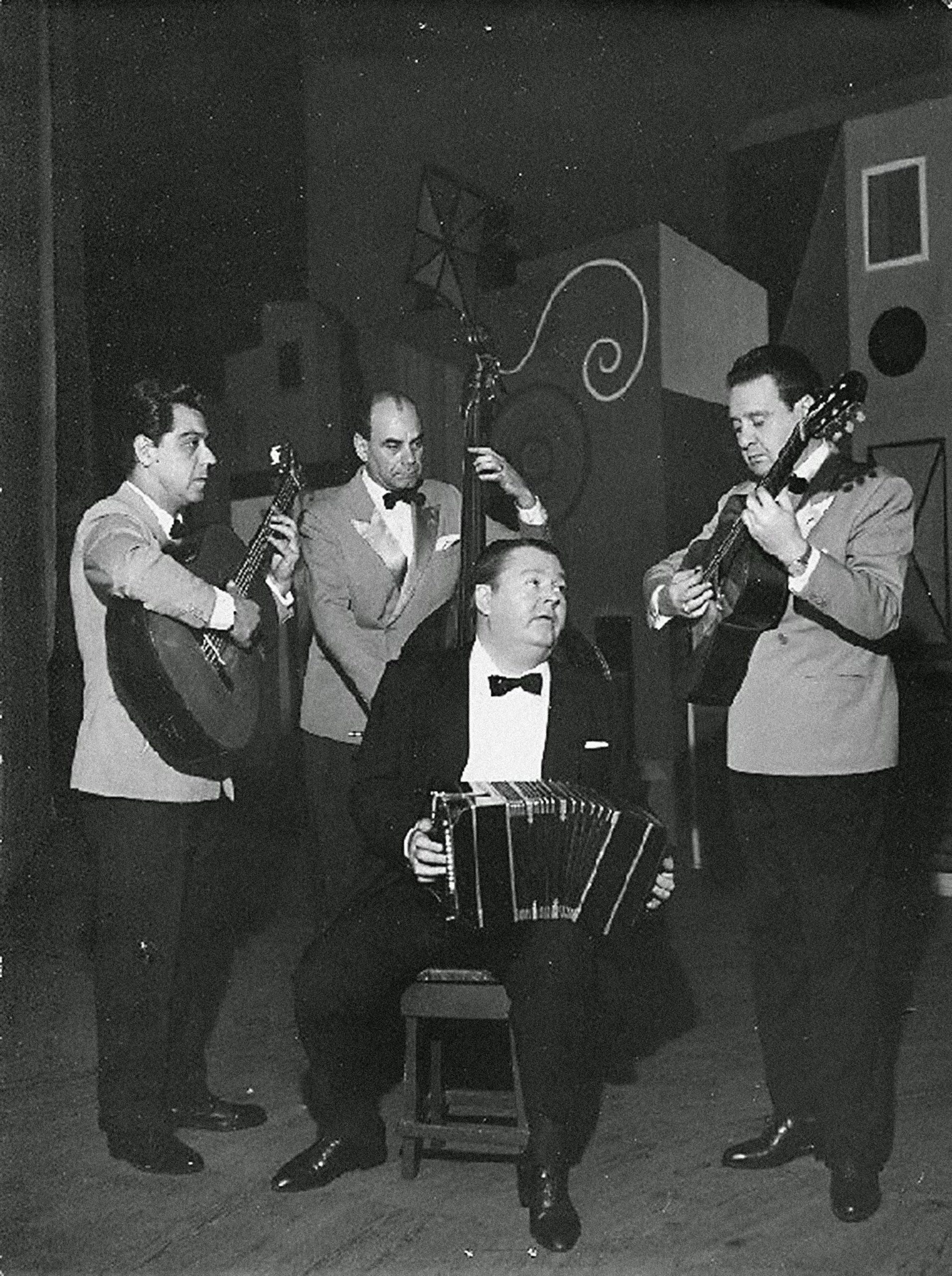
WP 5.1. Cuarteto Troilo-Grela, from left to right Ernesto Báez, guitarrón; Eugenio Pro, bass; Aníbal Troilo, bandoneón; and Roberto Grela, guitar. Public Domain, from Blog de José María Otero, https://josote56.blogspot.com/.

WL 5.1. “Los mareados” (“The Drunkards”) by Juan Carlos Cobián/Enrique Cadícamo, recorded by Roberto Grela.
WL 5.1. “Los mareados” (“The Drunkards”) by Juan Carlos Cobián/Enrique Cadícamo, recorded by Roberto Grela.
WL 5.4. “Las cuarenta” (literally “The Forties,” but more poetically “The Harsh Truths”) by Roberto Grela/Francisco Gorrindo, recorded by Alfredo Sadi and Roberto Grela.
WL 5.6. “Última Actuación de Aníbal Troilo.” ‘SIMPLEMENTE PICHUCO’, 17 de Mayo de 1975.
Adamovsky, Ezequiel. “A Strange Emblem for a (Not So) White Nation: La Morocha Argentina in the Latin American Racial Context, c. 1900–2015.” Journal of Social History 50, no. 2 (Winter 2016): 386–410.
Alem, Javier. “Pampero (Tango). Arreglo Para Guitarra de Aníbal Arias. Copia, Revisión y Desgrabación de Javier Alem,” n.d.
Arias, Aníbal. “ARREGLOS PARA GUITARRA SOLA,” May 26, 2012. https://anibalarias.wordpress.com/sheet-music.
Astarita, Gaspar J. Abel Fleury: Vida y obra. Chivilcoy, Argentina: Editorial GraFer, 1995.
Barrera, José Sebastián. “La guitarra en el tango.” Trabajo final, Facultad Latinoamericana de Ciencias Sociales, 2016.
Buffa, Pablo. “Tango y Jazz: Cuando Carlos García, Roberto Grela y José Canet dirigían sus orquestas de jazz.” La Campaña. December 16, 1996, sec. Suplemento de tango y lunfardo.
Burec, Lorena. “El tango académico para guitarra sus antecedents, recursos técnicos y expresivos, (notación y forma, género y estilo); análisis de algunas obras.” Universidad Nacional de Cuyo, 2009.
Estilos guitarrísticos del tango en el Río de la Plata: Un siglo de historia. Buenos Aires: Editorial Autores de Argentina, 2015.
Ferrer, Horacio. El Libro del tango. Arte popular de Buenos Aires. 2nd ed. 3 vols. Buenos Aires: Antonio Tersol, 1980.
Inventario del tango. Vol. 1. 2 vols. Buenos Aires: Fondo Nacional de las Artes, 1999.
García Brunelli, Omar. “Grela, Roberto.” In Diccionario de la música española e hispanoamericana, V:896–97. Madrid: Sociedad General de Autores y Editores, 1999.
Graciano, Julián. Método de Guitarra Tango. Buenos Aires: Melos, 2016.
Tango Licks Entrevistas // Felipe Traine Por Julián Graciano, 2020. www.youtube.com/watch?v=J8mLzh5W_Ag.
Henríguez, Sebastián. La Guitarra En El Tango: Método Fundamental Para Aprender a Tocar Tango. Buenos Aires: Tango sin fin, 2018.
“La guitarra mayor del tango.” Los grandes del tango 1, no. 52 (October 1991): 6–35.
Plesch, Melanie. “The Guitar in Nineteenth-Century Buenos Aires: Towards a Cultural History of an Argentine Musical Emblem.” PhD diss., University of Melbourne, 1998.
Prat, Domingo. A Biographical, Bibliographical, Historical, Critical Dictionary of Guitars (Related Instruments), Guitarists (Teachers, Composers, Performers, Lutenists, Amateurs), Guitar-Makers (Luthiers), Dances and Songs, Terminology. Columbus, OH: Editions Orphée, 1986.
Priore, Oscar del. Toda Mi Vida: Aníbal Troilo. Buenos Aires: JVE Ediciones, 2003.
Reynaldo, Lois. “La Fiesta del tango en el Teatro Colón.” La Campaña. April 12, 1987, sec. Suplemento de tango y lunfardo.
Ribot, Sara. “Aníbal Arias: La guitarra ha llegado a la Academia Nacional del Tango.” La Campaña. September 17, 1992, sec. Suplemento de tango y lunfardo.
“Última Actuación de Aníbal Troilo. ‘SIMPLEMENTE PICHUCO’, 17 de Mayo de 1975 – YouTube.” Accessed June 2, 2021. www.youtube.com/watch?v=8d9ZD8Z-OIk.
Adamovsky, Ezequiel. “A Strange Emblem for a (Not So) White Nation: La Morocha Argentina in the Latin American Racial Context, c. 1900–2015.” Journal of Social History 50, no. 2 (Winter 2016): 386–410.
Alem, Javier. “Pampero (Tango). Arreglo Para Guitarra de Aníbal Arias. Copia, Revisión y Desgrabación de Javier Alem,” n.d.
Arias, Aníbal. “ARREGLOS PARA GUITARRA SOLA,” May 26, 2012. https://anibalarias.wordpress.com/sheet-music.
Astarita, Gaspar J. Abel Fleury: Vida y obra. Chivilcoy, Argentina: Editorial GraFer, 1995.
Barrera, José Sebastián. “La guitarra en el tango.” Trabajo final, Facultad Latinoamericana de Ciencias Sociales, 2016.
Buffa, Pablo. “Tango y Jazz: Cuando Carlos García, Roberto Grela y José Canet dirigían sus orquestas de jazz.” La Campaña. December 16, 1996, sec. Suplemento de tango y lunfardo.
Burec, Lorena. “El tango académico para guitarra sus antecedents, recursos técnicos y expresivos, (notación y forma, género y estilo); análisis de algunas obras.” Universidad Nacional de Cuyo, 2009.
Estilos guitarrísticos del tango en el Río de la Plata: Un siglo de historia. Buenos Aires: Editorial Autores de Argentina, 2015.
Ferrer, Horacio. El Libro del tango. Arte popular de Buenos Aires. 2nd ed. 3 vols. Buenos Aires: Antonio Tersol, 1980.
Inventario del tango. Vol. 1. 2 vols. Buenos Aires: Fondo Nacional de las Artes, 1999.
García Brunelli, Omar. “Grela, Roberto.” In Diccionario de la música española e hispanoamericana, V:896–97. Madrid: Sociedad General de Autores y Editores, 1999.
Graciano, Julián. Método de Guitarra Tango. Buenos Aires: Melos, 2016.
Tango Licks Entrevistas // Felipe Traine Por Julián Graciano, 2020. www.youtube.com/watch?v=J8mLzh5W_Ag.
Henríguez, Sebastián. La Guitarra En El Tango: Método Fundamental Para Aprender a Tocar Tango. Buenos Aires: Tango sin fin, 2018.
“La guitarra mayor del tango.” Los grandes del tango 1, no. 52 (October 1991): 6–35.
Plesch, Melanie. “The Guitar in Nineteenth-Century Buenos Aires: Towards a Cultural History of an Argentine Musical Emblem.” PhD diss., University of Melbourne, 1998.
Prat, Domingo. A Biographical, Bibliographical, Historical, Critical Dictionary of Guitars (Related Instruments), Guitarists (Teachers, Composers, Performers, Lutenists, Amateurs), Guitar-Makers (Luthiers), Dances and Songs, Terminology. Columbus, OH: Editions Orphée, 1986.
Priore, Oscar del. Toda Mi Vida: Aníbal Troilo. Buenos Aires: JVE Ediciones, 2003.
Reynaldo, Lois. “La Fiesta del tango en el Teatro Colón.” La Campaña. April 12, 1987, sec. Suplemento de tango y lunfardo.
Ribot, Sara. “Aníbal Arias: La guitarra ha llegado a la Academia Nacional del Tango.” La Campaña. September 17, 1992, sec. Suplemento de tango y lunfardo.
“Última Actuación de Aníbal Troilo. ‘SIMPLEMENTE PICHUCO’, 17 de Mayo de 1975 – YouTube.” Accessed June 2, 2021. www.youtube.com/watch?v=8d9ZD8Z-OIk.
Salgán & Piazzolla
Accompanying Materials to Chapter 6:
Post-Golden Age Pillars: Horacio Salgán and Astor Piazzolla
by Kristin Wendland and Kacey Link
WP 6.1. Horacio Salgán, with the Quinteto Real, 1964. Martintobolski, used by permission via Wikimedia Commons License CC BY-SA 4.0.
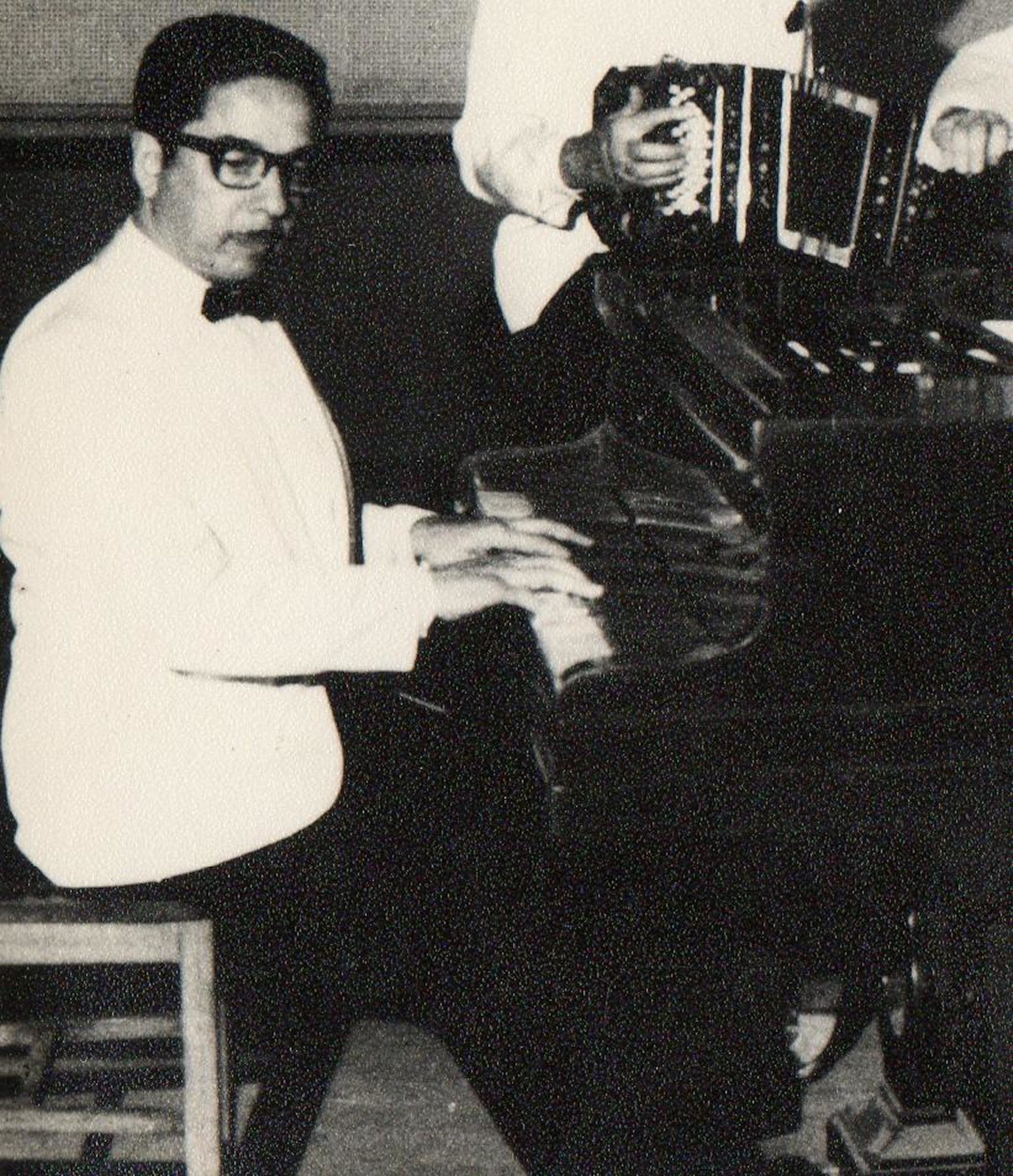
WP 6.1. Horacio Salgán, with the Quinteto Real, 1964. Martintobolski, used by permission via Wikimedia Commons License CC BY-SA 4.0.

WP 6.2. Astor Piazzolla, in his typical performance stance, 1975. Alicia D’Amico, Public domain, via Wikimedia Commons.

WE 6.2. Salgán, “Don Agustín Bardi,” opening motive, mm. 1–2, transcribed in 4/4. 
WE 6.3. Salgán, “Don Agustín Bardi,” fraseos at the beginning of the B Section, mm. 17–21, transcribed in 4/4.

WE 6.4. Salgán, “Grillito,” mm. 1–4, transcribed in 4/4.
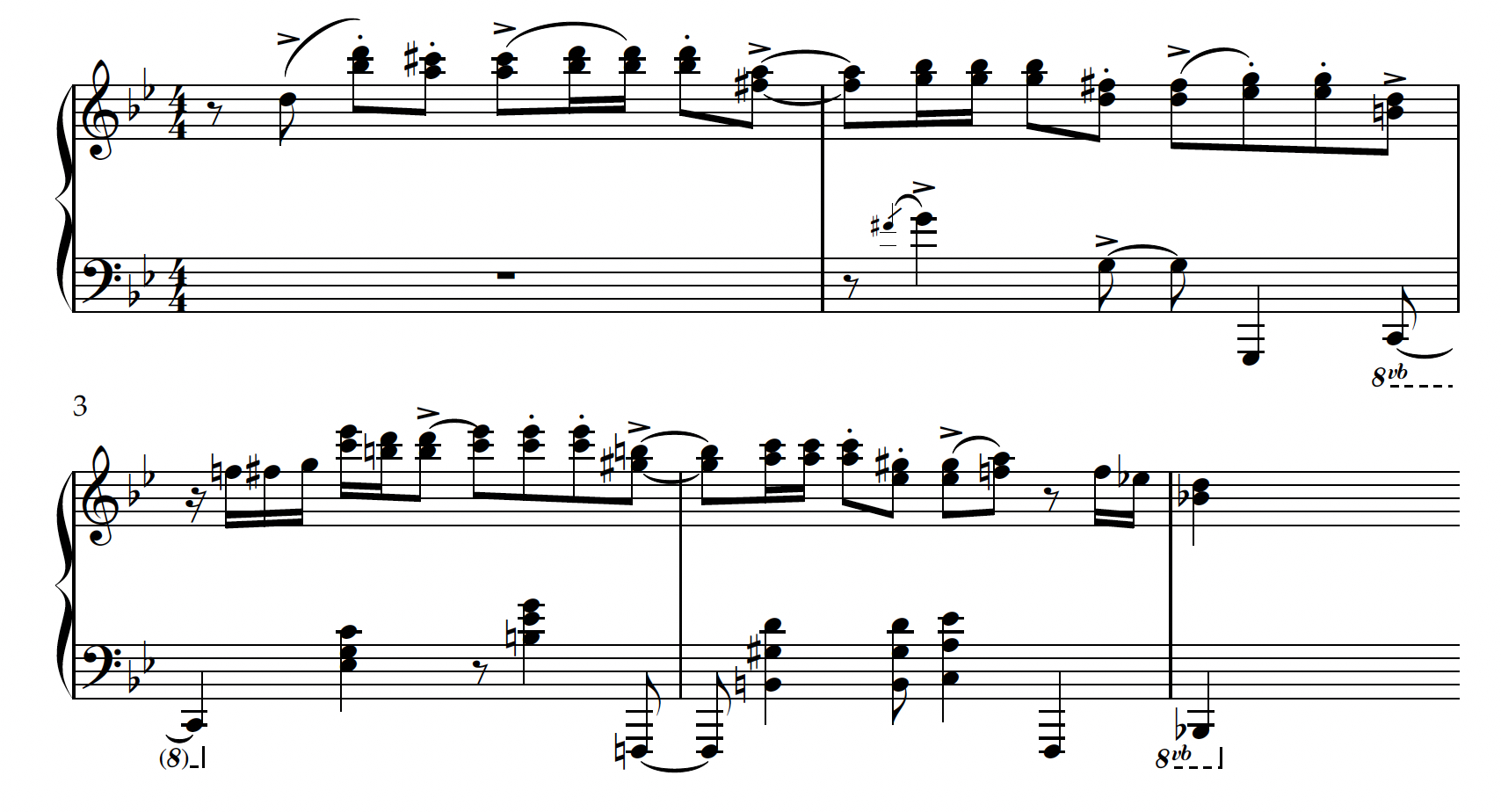
WE 6.5. Salgán, “Grillito,” rhythmic motive at the beginning of the C Section, mm. 33–34, transcribed in 4/4.

WE 6.6. Piazzolla, “La camorra I,” beginning of the A section proper, mm. 11–14.

WE 6.7. Piazzolla, “La camorra I,” beginning of fugal section, mm. 79–82.

WL 6.1. “Don Agustín Bardi” (referring to the guardia vieja tanguero) by Horacio Salgán, performed by Salgán and his orchestra.
WL 6.1. “Don Agustín Bardi” (referring to the guardia vieja tanguero) by Horacio Salgán, performed by Salgán and his orchestra.
WL 6.3. “Milonga del ángel” (“Angel Milonga”) by Astor Piazzolla, performed by Piazzolla and his quintet.
Azzi, María Susana. “The Tango, Peronism, and Astor Piazzolla during the 1940s and 1950s.” In From Tejano to Tango, edited by Walter Aaron Clark, 25–40. New York: Routledge, 2002.
Azzi, María Susana, and Simon Collier. Le Grand Tango: The Life and Music of Astor Piazzolla. New York: Oxford University Press, 2000.
Bolasell, Michel. La revolución del tango: la nueva edad de oro. Buenos Aires: Corregidor, 2011.
García Brunelli, Omar. Discografía básica del tango, 1905–2010: su historia a través de las grabaciones. Buenos Aires: Gourmet Musical Ediciones, 2010.
García Brunelli, Omar, ed. Estudios sobre la obra de Astor Piazzolla. Buenos Aires: Gourmet Musical, 2008.
Gorin, Natalio. Astor Piazzolla: A Memoir. Translated, annotated, and expanded by Fernando Gonzalez. Portland, OR: Amadeus Press, 2001.
Himshoot, Oscar. “Salgán – Interview to Horacio Salgán.” Todotango.com. Accessed September 24, 2022. www.todotango.com/english/history/chronicle/5/Salgan-Interview-to-Horacio-Salgan.
Link, Kacey, and Kristin Wendland. Tracing Tangueros: Argentine Tango Instrumental Music. New York: Oxford University Press, 2016.
Piazzolla, Diana. Astor. Buenos Aires: Corregidor, 2005.
Salgán, Horacio. Arreglos para orquesta típica: tradición e innovación en manuscritos originales. Buenos Aires: Biblioteca Nacional and TangoVia, 2008.
Salgán, Horacio. Curso de Tango/ Tango Course. Buenos Aires: Pablo J. Polidoro, 2001.
Sierra, Luis Adolfo. El tango romanza. Enrique Delfino, Juan Carlos Cobián, Francisco de Caro, Lucio Demare, Joaquí Mora, and Horacio Salgán. Buenos Aires: Academia Porteña del Lunfardo, 1987.
Ursini, Sonia. Horacio Salgán: la supervivencia de un artista en el tiempo. Buenos Aires: Corregidor, 1993.
Azzi, María Susana. “The Tango, Peronism, and Astor Piazzolla during the 1940s and 1950s.” In From Tejano to Tango, edited by Walter Aaron Clark, 25–40. New York: Routledge, 2002.
Azzi, María Susana, and Simon Collier. Le Grand Tango: The Life and Music of Astor Piazzolla. New York: Oxford University Press, 2000.
Bolasell, Michel. La revolución del tango: la nueva edad de oro. Buenos Aires: Corregidor, 2011.
García Brunelli, Omar. Discografía básica del tango, 1905–2010: su historia a través de las grabaciones. Buenos Aires: Gourmet Musical Ediciones, 2010.
García Brunelli, Omar, ed. Estudios sobre la obra de Astor Piazzolla. Buenos Aires: Gourmet Musical, 2008.
Gorin, Natalio. Astor Piazzolla: A Memoir. Translated, annotated, and expanded by Fernando Gonzalez. Portland, OR: Amadeus Press, 2001.
Himshoot, Oscar. “Salgán – Interview to Horacio Salgán.” Todotango.com. Accessed September 24, 2022. www.todotango.com/english/history/chronicle/5/Salgan-Interview-to-Horacio-Salgan.
Link, Kacey, and Kristin Wendland. Tracing Tangueros: Argentine Tango Instrumental Music. New York: Oxford University Press, 2016.
Piazzolla, Diana. Astor. Buenos Aires: Corregidor, 2005.
Salgán, Horacio. Arreglos para orquesta típica: tradición e innovación en manuscritos originales. Buenos Aires: Biblioteca Nacional and TangoVia, 2008.
Salgán, Horacio. Curso de Tango/ Tango Course. Buenos Aires: Pablo J. Polidoro, 2001.
Sierra, Luis Adolfo. El tango romanza. Enrique Delfino, Juan Carlos Cobián, Francisco de Caro, Lucio Demare, Joaquí Mora, and Horacio Salgán. Buenos Aires: Academia Porteña del Lunfardo, 1987.
Ursini, Sonia. Horacio Salgán: la supervivencia de un artista en el tiempo. Buenos Aires: Corregidor, 1993.
Tango & Jazz
Accompanying Materials to Chapter 7:
Tango and Jazz: Cross-Genre Relations in History and Practice
by Julián Graciano
WE 7.1. In unison, “A tus pies” (“To Your Dancing Feet”) by Julián Graciano. See corresponding WA 7.1.

WE 7.1. In unison, “A tus pies” (“To Your Dancing Feet”) by Julián Graciano. See corresponding WA 7.1.


WE 7.3. Bandoneón right–hand and left–hand voicing, “Trasnochado” (“Night Owl”) by Julián Graciano. See corresponding WA 7.3.


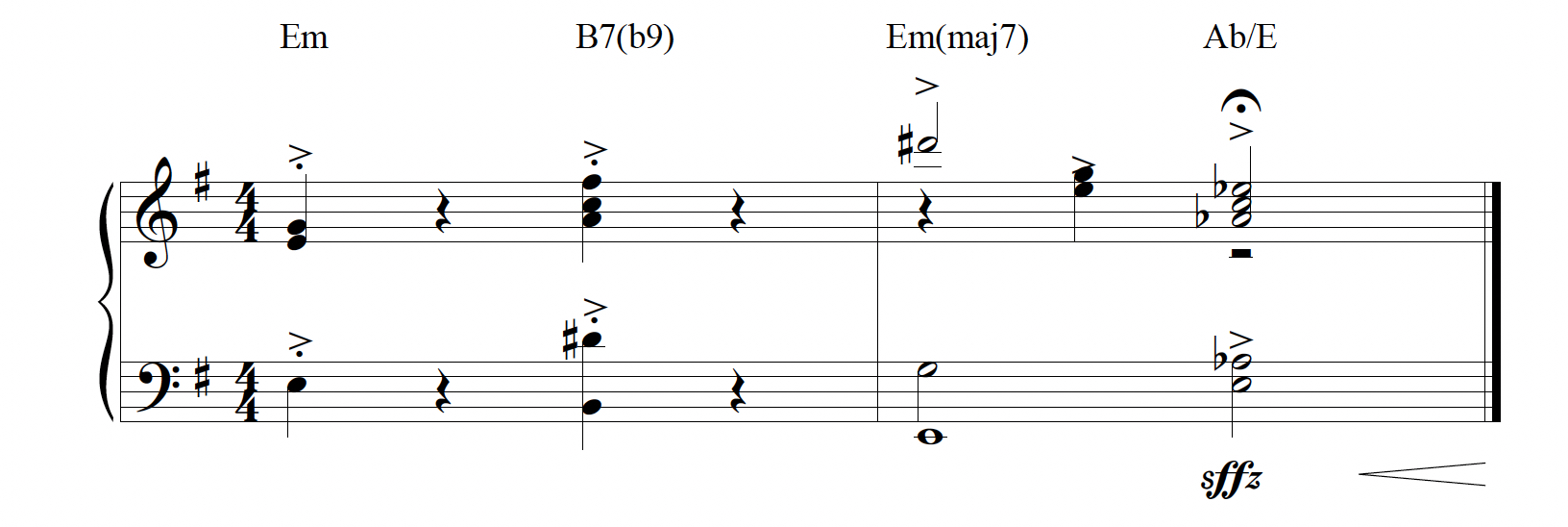

WE 7.7. Marcato in 4, “De tanguistas” (“A Tango Player’s Way”) by Julián Graciano. See corresponding WA 7.7.


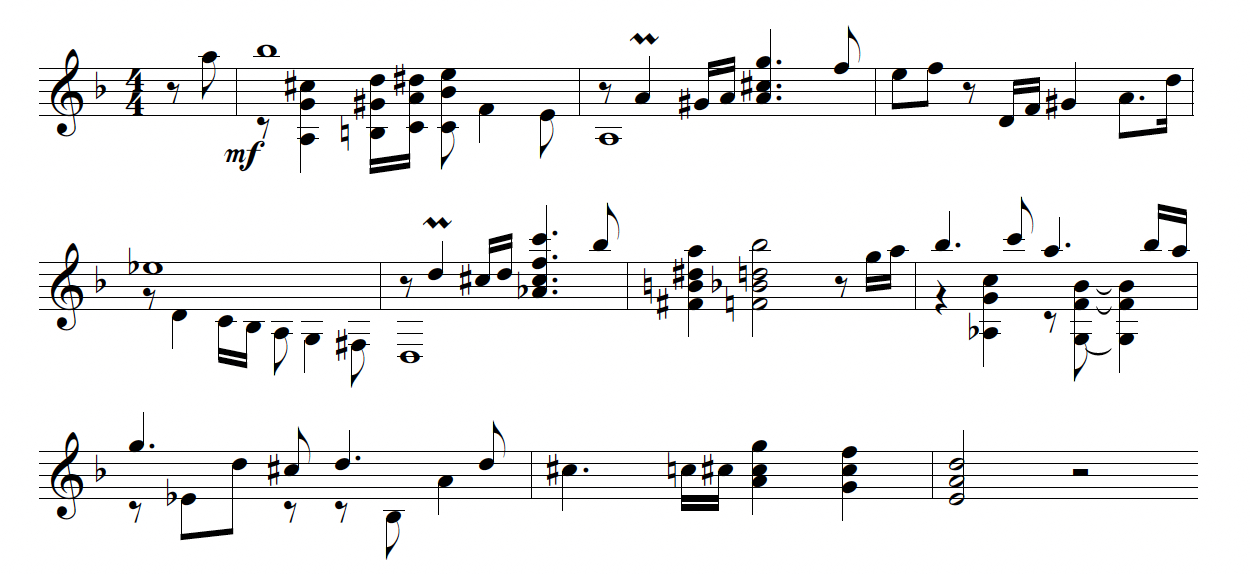



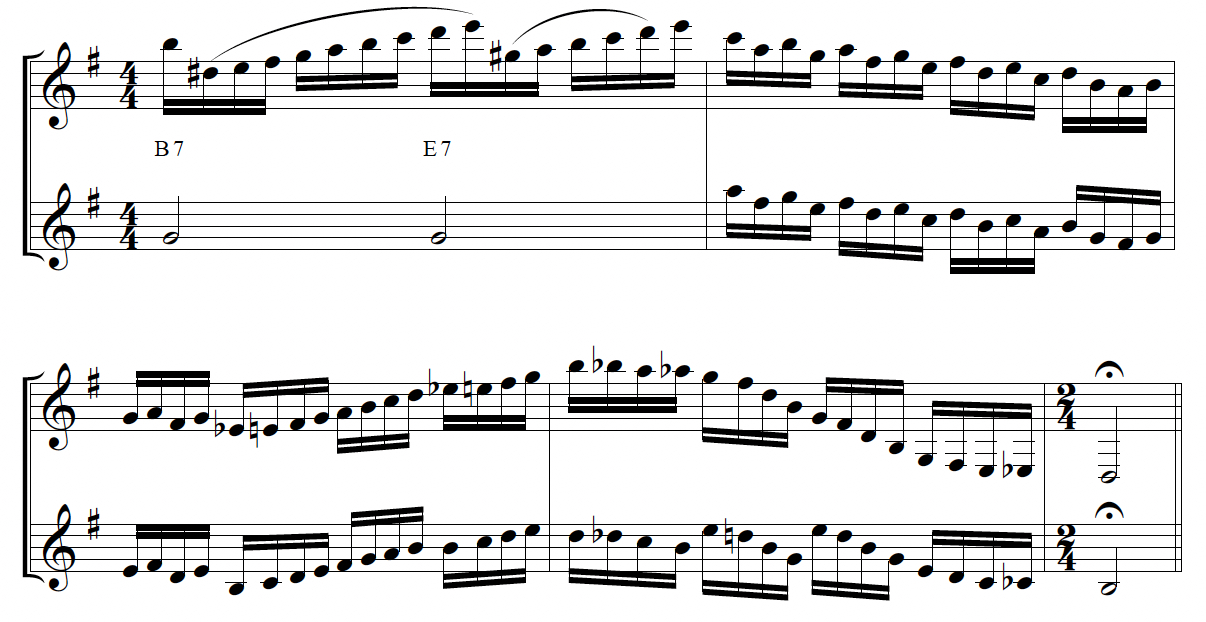
WE 7.14. Traditional marcato (bow), “Un tal Gardel” (“A Man Called Gardel”) by Julián Graciano. See corresponding WA 7.14.

WE 7.15. Jazz marcato (pizzicato), “Ocaso en la ciudad” by Julián Graciano. See corresponding WA 7.15.

 b. “Caminos” (“Paths”) by Julián Graciano. See corresponding WA 7.16b.
b. “Caminos” (“Paths”) by Julián Graciano. See corresponding WA 7.16b.

WE 7.17. Combining techniques marcato and arrastre, “A tus pies” (“To Your Dancing Feet”) by Julián Graciano. See corresponding WA 7.17.


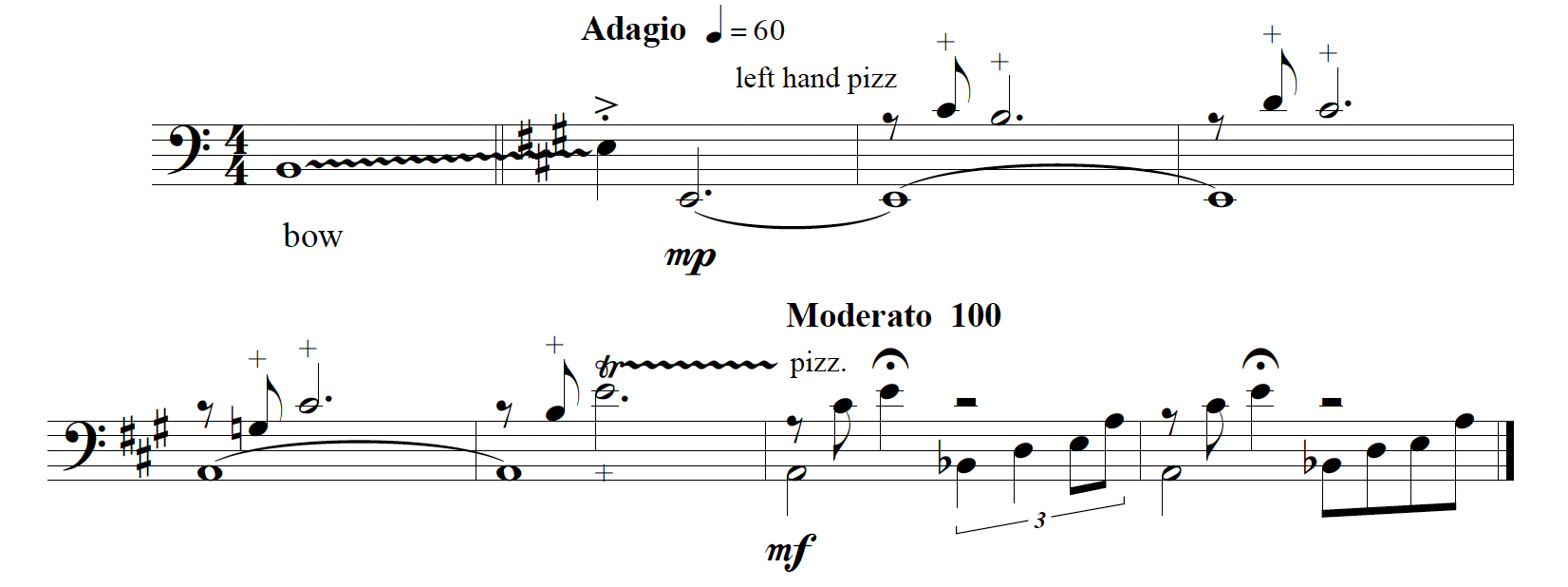

WE 7.22. Milonga, “Milonga de mis amores” (“My Beloved Milonga”) by Pedro Laurenz/José María Contursi. See corresponding WA 7.22.



WE 7.25. Free form outline, “Ocaso en la ciudad” by Julián Graciano (no corresponding audio).
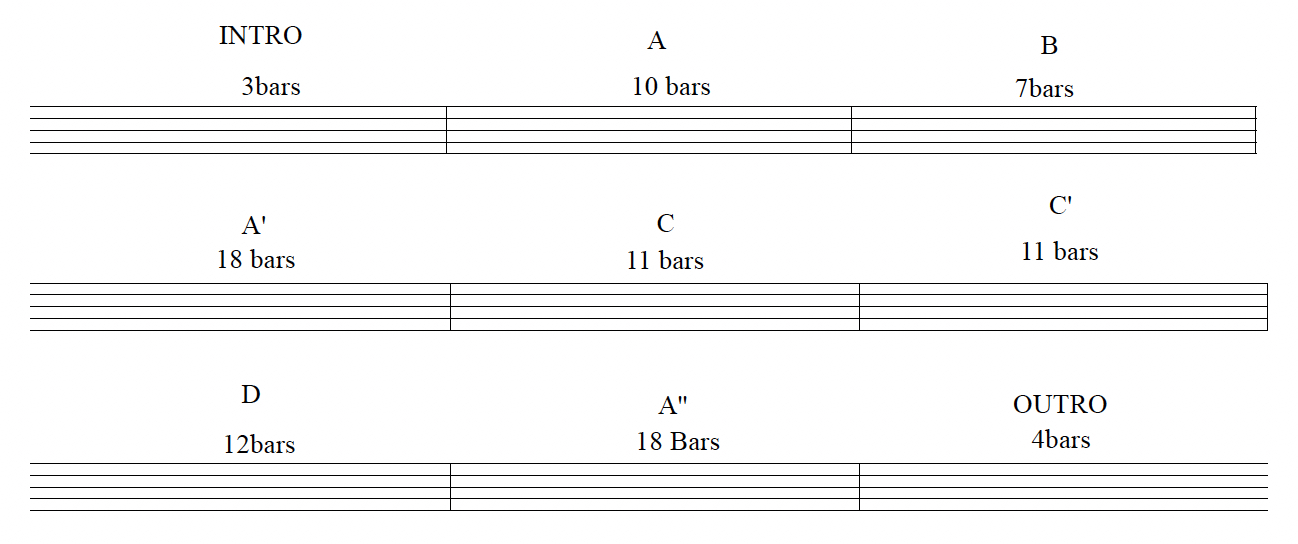

WE 7.27. Chord changes for an improvised solo, “Bien de abajo” (“From the Roots”) by Julián Graciano. See corresponding WA 7.27.
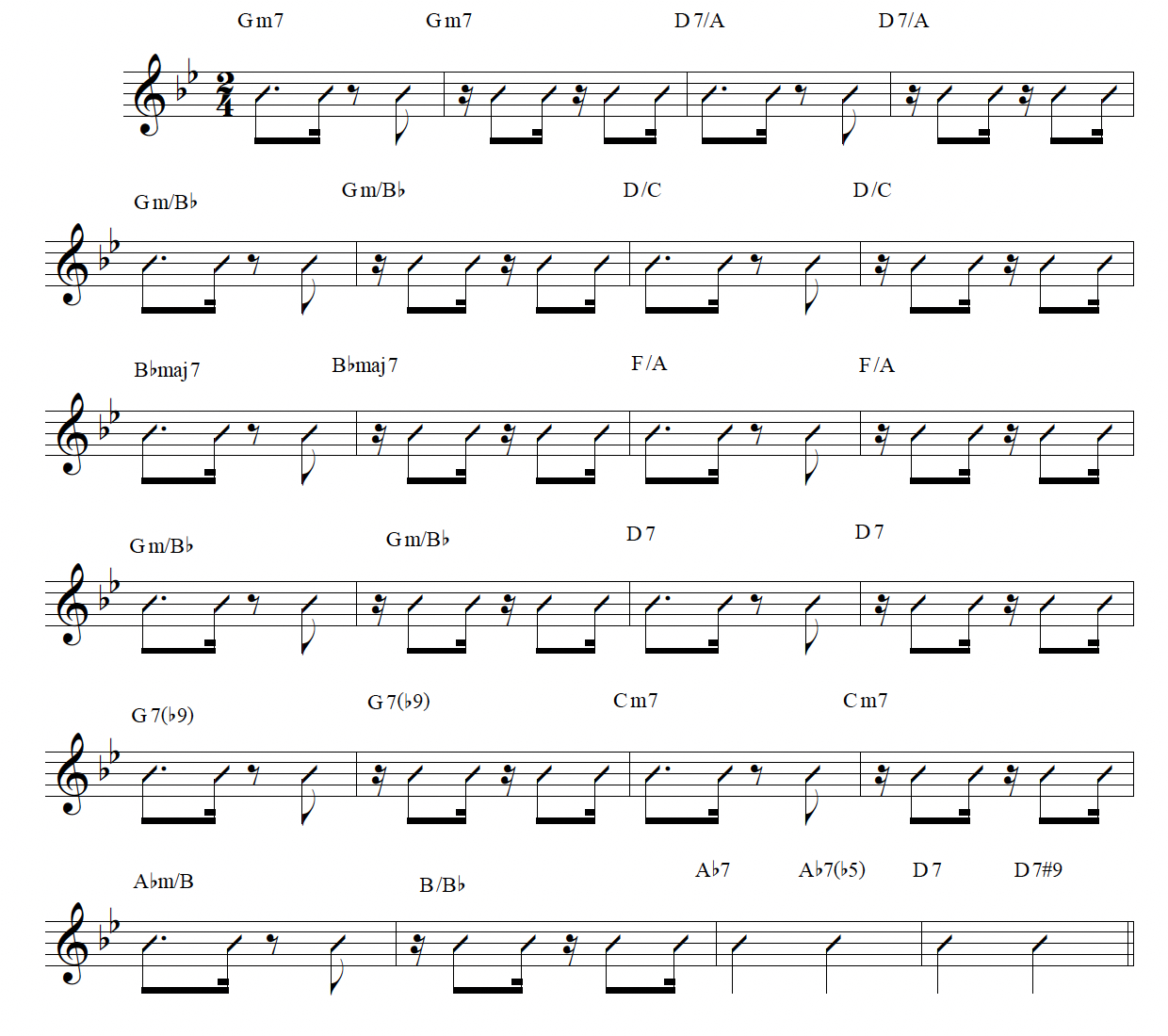


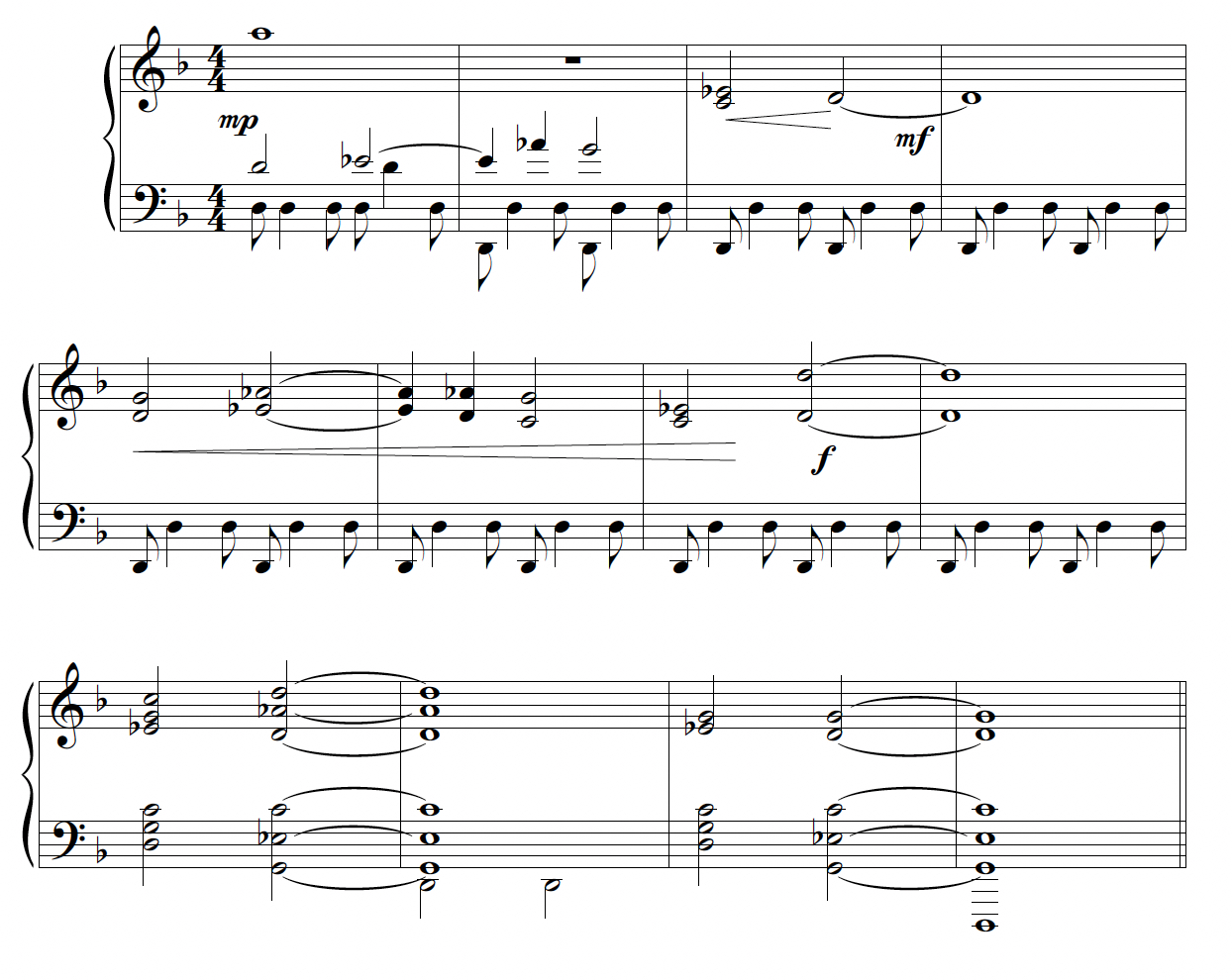




WE 7.35. Set of chord changes for an improvised solo, “Buenos Aires negra” (“Black Buenos Aires”) by Julián Graciano. See corresponding WA 7.35.
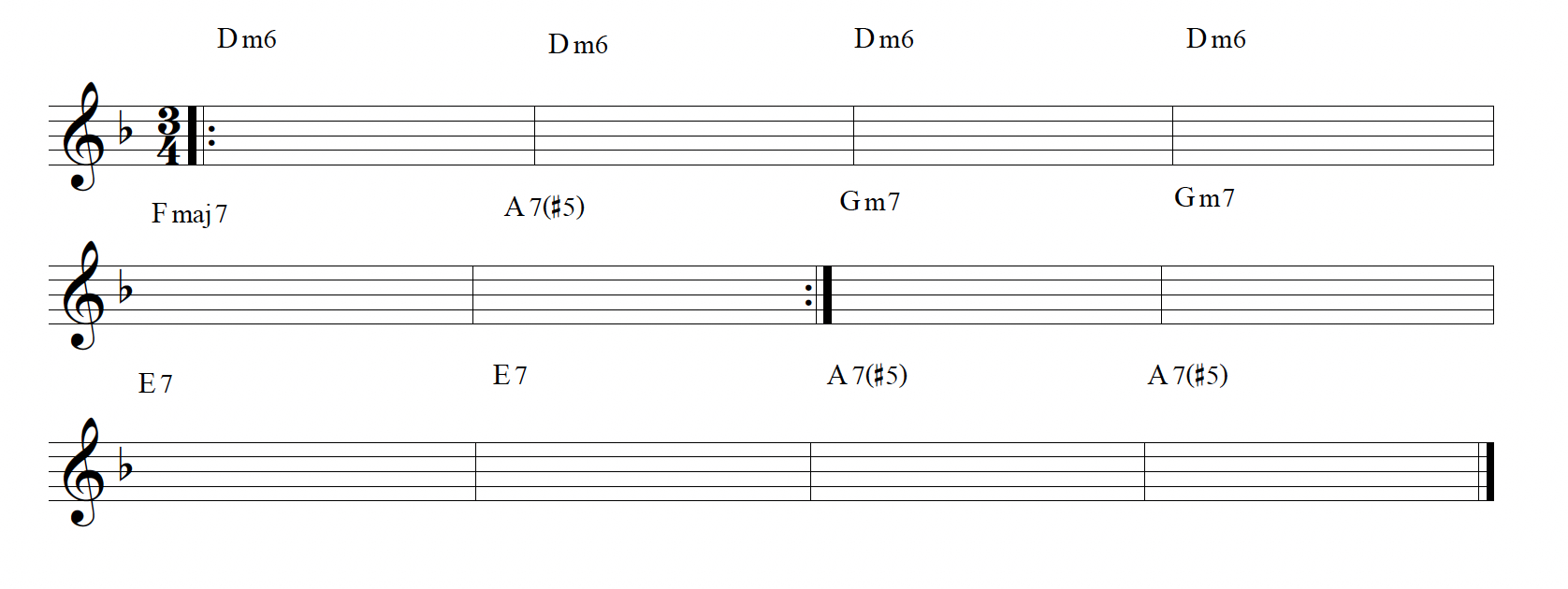



WA 7.1. “A tus pies” (“To Your Dancing Feet”) by Julián Graciano. See corresponding WE 7.1.
WA 7.1. “A tus pies” (“To Your Dancing Feet”) by Julián Graciano. See corresponding WE 7.1.
WA 7.2. “Mandinga” (a name for a South American devil, derived from West African culture) by Julián Graciano. See corresponding WE 7.2.
WA 7.3. “Trasnochado” (“Night Owl”) by Julián Graciano. See corresponding WE 7.3.
WA 7.4. “Tres + uno” (“Three Plus One”) by Julián Graciano. See corresponding WE 7.4.
WE 7.5. “Eduardo y Eduardo” (“Eduardo and Eduardo”) by Julián Graciano. See corresponding WA 7.5.
WE 7.6. “Puntos cardinales” (“Cardinal Points”) by Julián Graciano. See corresponding WA 7.6.
WA 7.7. “De tanguistas” (“A Tango Player’s Way”) by Julián Graciano. See corresponding WE 7.7.
WA 7.8. “Tango Ritual 1” by Julian Graciano. See corresponding WE 7.8.
WA 7.9. “Déjà vu” (“Already Seen”) by Julián Graciano. See corresponding WE 7.9.
WA 7.10. “Ocaso en la ciudad” (“Rush Hour in the City”) by Julián Graciano. See corresponding WE 7.10.
WA 7.11. “Al gran capitán” (“To the Great Captain”) by Julián Graciano. See corresponding WE 7.11.
WA 7.12. “Medianoche la ciudad” (“Midnight in the City”) by Julián Graciano. See corresponding WE 7.12.
WA 7.13. “Un tal Gardel” (“A Man Called Gardel”) by Julián Graciano. See corresponding WE 7.13.
WA 7.14. “Un tal Gardel” (“A Man Called Gardel”) by Julián Graciano. See corresponding WE 7.14.
WA 7.15. “Ocaso en la ciudad” by Julián Graciano. See corresponding WE 7.15.
WA 7.16a. “Tango en negro” (“Tango in Black”) by Julián Graciano. See corresponding WE 7.16a.
WA 7.16b. “Caminos” (“Paths”) by Julián Graciano. See corresponding WE 7.16b.
WA 7.17. “A tus pies” (“To Your Dancing Feet”) by Julián Graciano. See corresponding WE 7.17.
WA 7.18. “Eduardo y Eduardo” by Julián Graciano. See corresponding WE 7.18.
WA 7.19. “Puntos Cardinales” by Julián Graciano. See corresponding WE 7.19.
WA 7.20. “Puntos Cardinales” by Julián Graciano. See corresponding WE 7.20.
WA 7.21. “Don Agustín Bardi,” Horacio Salgán. See corresponding WE 7.21.
WA 7.22. “Milonga de mis amores” (“My Beloved Milonga”) by Pedro Laurenz/José María Contursi. See corresponding WE 7.22.
WA 7.23. “Palomita blanca” (“Little White Dove”) by Anselmo Aieta and Francisco García Jimenez. See corresponding WE 7.23.
WA 7.24. “Un tal Bach” (“A Man Called Bach”) by Julián Graciano. See corresponding WE 7.24.
WA 7.26. “Mandinga” by Julián Graciano. See corresponding WE 7.26.
WA 7.27. “Bien de abajo” (“From the Roots”) by Julián Graciano. See corresponding WE 7.27.
WA 7.28. “De Tanguistas” (“A Tango Player’s Way”) by Julián Graciano. See corresponding WE 7.28.
WA 7.29 “Amanece la ciudad” (“The City Awakes”) by Julián Graciano. See corresponding WE 7.29.
WA 7.30. “Tres + uno” by Julián Graciano. See corresponding WE 7.30.
WA 7.31. “Caminos” (“Paths”) by Julián Graciano. See corresponding WE 7.31.
WA 7.32. “Medianoche la ciudad” by Julián Graciano. See corresponding WE 7.32.
WA 7.33. “Trasnochado” by Julián Graciano. See corresponding WE 7.33.
WA 7.34. “Eduardo y Eduardo,” Julián Graciano. See corresponding WE 7.34.
WA 7.35. “Buenos Aires negra” (“Black Buenos Aires”) by Julián Graciano. See corresponding WE 7.35.
WA 7.36. “Para quién escribo” (“For Whom I Write”) by Julián Graciano. See corresponding WE 7.36.
WA 7.37. “En silencio” (“In Silence”) by Julián Graciano. See corresponding WE 7.37.
WA 7.38. “Tango en negro” (“Tango in Black”) by Julián Graciano. See corresponding WE 7.38.
WL 7.11. “Sónico” (“Sonic”) by Eduardo Rovira, recorded by the Eduardo Rovira y su agrupación de tango moderno.
WL 7.19. “Ritual” (“Ritual”) by Osvaldo Berlinghieri, recorded by the Baffa Berlinghieri Orquesta.
Aebersold, Jamey. Charlie Parker Omnibook. Lynbrook, NY: Atlantic Music Corp, 1978.
Aguilar, Pedro. El Tango. Buenos Aires: Manuscrito, 1997.
Alchourrón, Rodolfo. Composición y arreglos de música popular. Buenos Aires: Ricordi Americana, 1991.
Baker, David. How to Play Bebop. Vol. 1–3. Van Nuys, CA: Alfred Publishing Co., 1987.
Jazz Improvisation. Van Nuys, CA: Alfred Publishing Co, 1983.
Jazz Pedagogy: A Comprehensive Method of Jazz Education for Teacher and Student. Van Nuys, CA: Alfred Publishing Co., 1989.
Modern Concept in Jazz Improvisation. Van Nuys, CA: Alfred Publishing Co., 1990.
Bergonzi, Jerry. Inside Improvisation Series. Vol. 1–7. Rottenburg: Advance Music, 1994.
Camps, Pompeyo. Tango y Ragtime. Buenos Aires: Manuscript, 1976.
Coker, Jerry, James Casale, Gary Campbell, and Jerry Greene. Patterns for Jazz. Miami, FL: Studio P/R, 1970.
Delamont, Gordon. Modern Twelve-Tone Technique. Delevan, NY: Kendor Music Inc., 1973.
Felts, Randy. Reharmonization Techniques. Boston: Berklee Press, 2002.
Goldstein, Gil. Jazz Composer’s Companion. New York: Consolidated Music Publishers, 1981.
Graciano, Julián. Análisis Musical del Tango. Buenos Aires: Manuscript, 2003.
Catálogo de obras de Eduardo Rovira. Buenos Aires: Manuscript, 2009.
El libro Real del Tango. Vol. 1–6. Buenos Aires: Melos Ediciones Musicales, 2020.
Método Guitarra Tango//Tango Guitar Method. Buenos Aires: Melos Ediciones Musicales, 2016.
Ortiz Oderigo, Néstor. La Música Afronortemericana. Buenos Aires: EUDEBA, 1962.
Pease, Ted. Jazz Composition: Theory and Practice. Boston: Berklee Press, 2003.
Pullig, Ken and Richard Lowell. Arranging for Large Ensemble. Boston: Berklee Press, 2003.
Rawlins, Robert, and Nor Eddine Bahha. Jazzology: The Encyclopedia of Jazz Theory for All Musicians. Milwaukee, WI: Hal Leonard Co., 2005.
Reilly, Jack. The Harmony of Bill Evans. Brooklyn, NY: Unichrom Ltd., 1992–1993.
Rossi, Vicente. Cosas de Negros. 2nd edition. Buenos Aires: Hachette S.A., 1958.
Salgán, Horacio. Curso de Tango. Buenos Aires: Pablo J. Polidoro, 2001. Translated into English by Will Genz and Marisa Hurtado as Tango Course, 2nd ed., 2001.
Sher, Chuck, and Bob Bauer. The New Real Book. Vol. 1–3. Petaluma, CA: Sher Music Co., 1988.
Sierra, Luis María. Historia de la Orquesta Típica. Buenos Aires: A. Peña Lillo Editor S.R., 1976.
Slonimsky, Nicolas. Thesaurus of Scales and Melodic Patterns. New York: Charles Scribner’s Sons, 1947.
The Real Book. Vol. 1–5. Milwaukee, WI: Hal Leonard Co, 2005.
Wetzel, Pascal. Bill Evans Fake Book. New York: Ludlow Music Inc., 1996.
Aebersold, Jamey. Charlie Parker Omnibook. Lynbrook, NY: Atlantic Music Corp, 1978.
Aguilar, Pedro. El Tango. Buenos Aires: Manuscrito, 1997.
Alchourrón, Rodolfo. Composición y arreglos de música popular. Buenos Aires: Ricordi Americana, 1991.
Baker, David. How to Play Bebop. Vol. 1–3. Van Nuys, CA: Alfred Publishing Co., 1987.
Jazz Improvisation. Van Nuys, CA: Alfred Publishing Co, 1983.
Jazz Pedagogy: A Comprehensive Method of Jazz Education for Teacher and Student. Van Nuys, CA: Alfred Publishing Co., 1989.
Modern Concept in Jazz Improvisation. Van Nuys, CA: Alfred Publishing Co., 1990.
Bergonzi, Jerry. Inside Improvisation Series. Vol. 1–7. Rottenburg: Advance Music, 1994.
Camps, Pompeyo. Tango y Ragtime. Buenos Aires: Manuscript, 1976.
Coker, Jerry, James Casale, Gary Campbell, and Jerry Greene. Patterns for Jazz. Miami, FL: Studio P/R, 1970.
Delamont, Gordon. Modern Twelve-Tone Technique. Delevan, NY: Kendor Music Inc., 1973.
Felts, Randy. Reharmonization Techniques. Boston: Berklee Press, 2002.
Goldstein, Gil. Jazz Composer’s Companion. New York: Consolidated Music Publishers, 1981.
Graciano, Julián. Análisis Musical del Tango. Buenos Aires: Manuscript, 2003.
Catálogo de obras de Eduardo Rovira. Buenos Aires: Manuscript, 2009.
El libro Real del Tango. Vol. 1–6. Buenos Aires: Melos Ediciones Musicales, 2020.
Método Guitarra Tango//Tango Guitar Method. Buenos Aires: Melos Ediciones Musicales, 2016.
Ortiz Oderigo, Néstor. La Música Afronortemericana. Buenos Aires: EUDEBA, 1962.
Pease, Ted. Jazz Composition: Theory and Practice. Boston: Berklee Press, 2003.
Pullig, Ken and Richard Lowell. Arranging for Large Ensemble. Boston: Berklee Press, 2003.
Rawlins, Robert, and Nor Eddine Bahha. Jazzology: The Encyclopedia of Jazz Theory for All Musicians. Milwaukee, WI: Hal Leonard Co., 2005.
Reilly, Jack. The Harmony of Bill Evans. Brooklyn, NY: Unichrom Ltd., 1992–1993.
Rossi, Vicente. Cosas de Negros. 2nd edition. Buenos Aires: Hachette S.A., 1958.
Salgán, Horacio. Curso de Tango. Buenos Aires: Pablo J. Polidoro, 2001. Translated into English by Will Genz and Marisa Hurtado as Tango Course, 2nd ed., 2001.
Sher, Chuck, and Bob Bauer. The New Real Book. Vol. 1–3. Petaluma, CA: Sher Music Co., 1988.
Sierra, Luis María. Historia de la Orquesta Típica. Buenos Aires: A. Peña Lillo Editor S.R., 1976.
Slonimsky, Nicolas. Thesaurus of Scales and Melodic Patterns. New York: Charles Scribner’s Sons, 1947.
The Real Book. Vol. 1–5. Milwaukee, WI: Hal Leonard Co, 2005.
Wetzel, Pascal. Bill Evans Fake Book. New York: Ludlow Music Inc., 1996.
Explore
Click the images below to navigate the sections.
A Brief History of Tango
Chapter 1
Tango Music
Chapters 2–7
Tango Song
Chapters 8–9
Tango Dance
Chapters 10–13
Interdisciplinary Tango Studies
Chapters 14–20
A Brief History of Tango
Chapter 1
Tango Music
Chapters 2–7
Tango Song
Chapters 8–9
Tango Dance
Chapters 10–13
Interdisciplinary Tango Studies
Chapters 14–20


